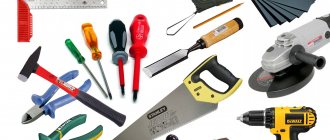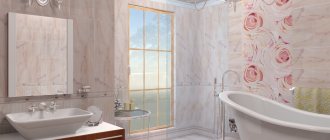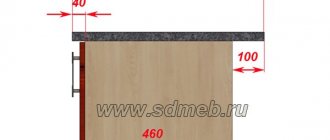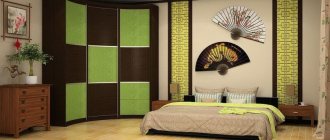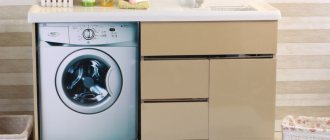Buying an oven for your kitchen means providing yourself with an excellent assistant and having ample opportunities for cooking a wide variety of dishes. A wide variety of similar household appliances are produced by industry. This is an electric or gas oven, the dimensions and volumes of which can be standard, with a body width of 60 cm and a depth of 55 cm, or non-standard, with smaller or larger dimensions. The products also differ in their operational properties: installation method, the presence of different modes used for cooking, and additional capabilities. Therefore, before purchasing equipment, it is important to determine the dimensions of the niche for building in an oven and become familiar with the characteristics of the models in detail. This will allow you to buy the best option for the device without spending extra money on options that you may never need.
Types of ovens
All devices can be divided into two large groups - according to the control method. Ovens can be:
- dependent - functioning only in alliance with the hob, on which the controls are located;
- independent - work autonomously. Such appliances can be placed anywhere in the kitchen, since the control panel is located on the front part.
Ovens are also classified according to their heating source:
- gas;
- electric.
Each of these options has its own pros and cons, which can be decisive when choosing kitchen appliances.
Adviсe
When purchasing a built-in wardrobe, you should pay attention to the following tips. It is recommended to first allocate space for equipment
The location of the device must be determined in advance. Even the smallest kitchen can have a convenient and multifunctional oven, as the market offers a wide variety of options. The functionality of the technology matters. A timer, a readiness sensor, and many temperature settings – all these are the main indicators of almost all ovens. If the equipment is equipped with additions in the form of a grill or steamer, its cost will be higher.
A lot of functionality is convenient for those people who really love to cook and constantly experiment in the kitchen. Electric ovens are sometimes equipped with a self-cleaning function, for which you will have to pay a considerable amount
However, if you have difficulties putting things in order in the kitchen, it is better to take care of this important detail.
When choosing, you can highlight the following main parameters:
- safety;
- functionality;
- design;
- fastener
However, they often do not fit into standard built-in niches. Multifunctional ovens are equipped with an electronic control unit, which has smaller dimensions. Such a device is convenient with keyboard or touch buttons.
You can store recipes for your favorite dishes in the device’s memory. The desired process is subsequently selected in accordance with the cooking program used. Combined control options, with mechanical knobs and an electronic display, are also considered convenient and fit standard niches.
The choice of equipment design is a personal preference of each buyer. Usually the oven is selected in accordance with the basic style of the room.
When choosing, you should also consider that the built-in oven may or may not be connected to the hob. Interconnected equipment is connected via one power cable. The manufacturer recommends connecting dependent devices to each other according to the instructions. Independent devices can be connected via two different wires and installed at any distance from each other. If the equipment is low-power (no higher than 3.5 kW), it is allowed to use an outlet.
Powerful equipment is connected by a power cable to a special machine. The wiring in the house must be suitable for connecting powerful equipment.
For useful tips on how to install an oven, watch the video below.
Gas or electric - advantages and disadvantages
The gas oven is heated by a burner located at the base of the chamber. This option is not able to provide uniform heating. It is quite difficult to achieve a golden brown crust in such an oven. Most often, the result is a burnt bottom combined with an uncooked top. However, the introduction of additional devices - such as a grill in the upper part of the chamber or a fan that increases the uniformity of hot air distribution - can offset this disadvantage.
Electric analogues have several heating elements - at least 2 - upper and lower, which can work both in a “team” and autonomously.
What are the advantages of a gas oven?
- Allows you to save energy and money for the owner - gas is much cheaper than electricity.
- It copes well with basic tasks - it can bake, stew, fry, dry - in the presence of convection. However, it does not allow simultaneous cooking on several levels.
- Most models have a budget price.
- Ensures safety - if there is a gas control function. Any gas leak will be immediately detected and blocked.
- Always at your service - dinner will be ready even when the power is off.
- Easy switching on thanks to automatic ignition.
Advantages of an electric oven
- Uniform heating of the chamber due to the presence of several heat sources in the design.
- Many automatic modes and additional functions are a real find for cooking fans.
- The ability to accurately set the required temperature, mode and cooking time.
- Safety – in comparison with the gas analogue.
- The presence of a self-cleaning function - pyrolytic or catalytic. During the first, purification is carried out by burning carbon deposits at a temperature of 500 degrees. The second method allows you to clean the cabinet while cooking. Special built-in elements help break down fat into carbon dioxide and water.
With all its advantages, the electric oven also has disadvantages, including:
- the need to match the level of power consumption of the device to the power of the electrical network;
- rising energy costs;
- high cost of equipment.
Gas or electricity
The first question when choosing an appliance is which oven to choose for the kitchen: gas or powered. When connecting a house to a centralized gas supply, the buyer selects a ready-made gas model. But in order to choose the right product, it is worth getting acquainted with the advantages and disadvantages of each type.
Gas today is cheaper than electricity, so to save money during operation, a gas built-in oven is more profitable. In addition, the advantages of gas equipment include:
- a gas burner provides quick heating compared to its electric counterpart;
- there is no need to lay electrical networks required when using devices;
- simplicity of design, which simplifies the operation and maintenance of equipment;
- no special skills required for use;
- the price of gas models is usually lower than electric ones.
The disadvantages of gas-powered products include:
- more dangerous equipment compared to electrical equipment;
- fewer functions;
- For electrical structures, the heating temperature of the working chamber is higher.
In addition, it is worth remembering that maintenance, any repairs, dismantling of equipment and connecting it to the system should only be performed by experienced specialists with a certificate of admission to servicing gas equipment.
Electric ovens have greater capabilities. Therefore, they are in great demand among consumers. In finished ovens, elements for heating the working space are located on all sides, including the top and bottom of the chamber. Different dishes can be prepared using a combination of different heating elements. For example, a combination of top and bottom heaters using convection or grilling. The main advantages of electric ovens are:
- uniform heating at high speed;
- the ability to select the desired function, which is ensured by the presence of automatic programs and cooking modes for various dishes;
- the cooking temperature range ranges from 30 °C to 300 °C;
- the presence of convection allows you to evenly distribute hot air throughout the entire volume of the oven and bake several dishes at once on different levels with an appetizing golden crust;
- possibility of use in the absence of a gas supply network and bottled gas;
- safety during operation.
Among the most popular are built-in ovens manufactured by Bosch.
How to choose an oven
The choice of a new stove should be approached with the utmost responsibility. The comfort and convenience of the housewife when using it, the quality and variety of dishes will depend on this. When purchasing, you must take into account the dimensions of the kitchen unit and the ability to connect to networks.
When purchasing, it is important to consider the following points:
- When replacing an oven, the dimensions of the old and new devices must be identical. Thanks to this, you will not have to change the furniture or adjust it to new sizes;
- number of family members – a standard oven may not be enough to cook a large amount of food at the same time. If the family is large, it is better to give preference to chambers with increased height - in such ovens you can place a larger number of baking sheets, and thus save cooking time;
- kitchen dimensions - it will be difficult to fit a spacious oven in a small room, since it will “eat up” the already scarce space. A miniature appliance is perfect for a small kitchen;
- the design of the product must correspond to the chosen style direction and color scheme;
- additional functions - built-in microwave, steamer, grill, shelf for heating plates - their presence greatly increases the cost of devices, but has a positive effect on the quality of dishes, making the cooking process as simple and comfortable as possible;
- additional drawers - if there is no place to place pans and pots, you can choose a model that will be equipped with storage spaces;
- self-cleaning function - will save a lot of time, effort and money on buying household chemicals;
- Russian-language instructions that will make it easy to understand the settings;
- devices that make the cooking process more comfortable - display, timer, clock;
- button and door locking system - to ensure the safety of life and health of children.
Preparatory work
To make furniture, it is advisable to have a workshop. You can use a large table in a free room. Make sure there is an outlet within walking distance to connect power tools and stock up on an extension cord. Organize your workplace lighting correctly.
If you are going to make a closet in a non-residential area, then take care of heating in winter and forced ventilation in hot summer. Large window openings will save energy consumption during the daytime. A workbench equipped with stops, sockets, vices and clamps will be a good help for assembling the cabinet.
Standard sizes of electric ovens
One of the main parameters when choosing equipment is the dimensions of the oven. The device must fit perfectly into the kitchen set. Manufacturers offer a wide range of different-sized models.
If the oven is used infrequently, it is more advisable to give preference to a small, compact option. However, keep in mind that the functionality of a miniature stove is most often limited. If additional functions are important to you, it is better to purchase an oven with standard dimensions.
Width
Standard ovens have a width of 60 cm. This is a generally accepted parameter that all manufacturers of these products adhere to. There are a huge number of options for ovens in this size range on the market. In this regard, it will not be difficult to select the optimal device for any design and promptly replace old equipment. Such ovens can be easily built into standard kitchen cabinets, so you don’t have to order expensive furniture of non-standard sizes for them.
Depth
An oven depth of 60 cm is considered optimal. It fits perfectly with a tabletop of standard width, which is also 60 cm. This surface allows you to conveniently place the necessary products for cooking, small household appliances, and provide sufficient distance to the upper tier cabinets. That is why standard sets are equipped with a tabletop of this width.
This oven depth allows you to use a spacious baking sheet, which significantly speeds up the cooking process. An oven with these parameters will fit seamlessly into the compartment under the hob, as well as into a vertical cabinet or kitchen column.
In case of limited space, you can choose models whose depth ranges from 50-55 cm. For small kitchens, compact options with a depth of 45 cm are optimal.
Height
The most common height of electric ovens is 60 cm. The lion's share of devices are produced with exactly these parameters. However, nothing prevents you from choosing an oven with a height of 70 or 90 cm with one large or two compact baking compartments. It is recommended to use such models in kitchens with a minimum area of 9 square meters. m. If the room does not have such parameters, you should choose smaller devices.
Assembling the connection diagram
So, all the materials are ready, you can proceed to assembly. Here is the connection diagram for all devices.
A two-pole circuit breaker is installed in the box. The machines have one feature - the ability to connect devices to them from different sides
That is, it does not matter where the supply cable is inserted and where the outlet cable is inserted. On one side, the phase and zero from the supply wire for the oven are connected to the machine. Since the machine is selected for 16 A, it will accordingly turn off the oven if high currents appear in it. On the other hand, the modules have exactly the same phase and zero, only two wires
One will connect to the hob, the second is the power wire from the distribution panel. That is, this is the wire that was connected to the old outlet. In this case, the hob plug is cut off and the connection is made directly to the machine. By the way, some stove models are not equipped with forks. But for the oven it is better to install a separate outlet. It can be located inside the box (six-module) or be mounted on the wall next to the device. All that remains is to connect the grounding circuit, for this purpose the busbar was installed inside the box. That is, the grounding wire coming from the distribution board, the grounding from the oven and the hob are simultaneously connected to it.
You can make the connection differently. To do this, you only need a 16 A machine, through which the oven will be connected. But in addition to the grounding busbar, you will have to install an additional busbar for phase and zero in the box. That is, there will be three tires in the box, so for this you will have to choose a larger device. For example, for six modules.
- The following are connected to the phase bus: the supply wire (meaning its phase wire), the supply wire of the hob and the wire connected to the machine.
- The zero bus is connected to the zero from the supply wire, from the hob and the wire going to the socket for the oven.
- A wire is drawn from the machine to the socket.
It is better to install the box somewhere below the base of the kitchen unit so that it is not visible and so that no one touches it.
In principle, these are the most correct decisions in this situation. But there is a better option. If you are renovating your apartment and decide to purchase built-in appliances, then leave the old cable for the hob. And for the oven, draw a new one with the required cross-section. And install a separate 16 A circuit breaker on the line. That is, you will have two sockets on the wall. Each one powers its own device. This is an ideal option for connecting an oven and hob.
Let us add that today electrical circuits are equipped with various types of protective devices, where the machine plays an important role. It turns off the power supply to household appliances if an increased current has formed in the network. This current burns out the supporting electrical circuits. But there is one more device, the installation of which is considered mandatory today. This is an RCD (residual current device).
It is necessary so that a person does not get an electric shock when there is a breakdown in the electrical circuit, and the voltage is transmitted to the metal housings of the same oven or hob. If a person touches the metal, he gets an electric shock. If there is an RCD, then it takes over these stray currents. This protective device can be installed inside the distribution board or near the outlet where the box was mounted.
Tips, Electrics
Standard sizes of gas ovens
When purchasing gas ovens, it becomes clear that they come in different sizes. Models with a depth of 50-55 cm and a width of 60 cm are considered standard. However, devices with these dimensions are not always easy to place in the kitchen, since after installing the furniture there may not be enough space to build in an oven or, conversely, there may be excess space.
Width
According to generally accepted standards, the width of a classic oven should be 60 cm. When building the device into a slightly larger cabinet, the only problem will be a violation of aesthetics and the formation of voids. If the free space is slightly smaller, this will make the installation of standard equipment impossible. In this case, you can purchase another option - a narrower one. It is for such situations that manufacturers have provided models with a width of 40, 45 cm. However, finding such an option is quite difficult - as a rule, at best, there are only one or two varieties of goods in this category in the store, or they are completely absent. This technique is the best option for integration into small-sized kitchen furniture sets designed for small spaces.
Depth
The standardized depth indicator for gas ovens is 60 cm. Less commonly, this parameter is 55 cm. This size is considered optimal - it was carefully selected by manufacturers based on the results of a huge number of studies and experiments. This is exactly the depth of the oven that is necessary for high-quality baking of the inside and outside of the food. Therefore, manufacturers rarely deviate from this parameter. There are products on sale with a shallow depth of 45 cm, but they are not in high demand due to their impracticality.
Height
The height of a standard gas oven is 60 cm. If additional functions are present, this parameter may increase, since it is simply impossible to save it. Manufacturers strive to satisfy all possible customer needs, so they are increasingly offering non-standard models, the dimensions of which can satisfy any needs.
Tabletop features
According to the standard, the depth of the tabletop is 60 centimeters. This volume was specially calculated by engineers, calculating the distance the housewife needs, taking into account convenience. Often, a buyer is looking for an oven of this height so that it can be placed not in a countertop, but in the space of a small wall cabinet. In this case, the expected dimensions of the equipment should be smaller than the standard ones.
Built-in stove height
If medium-sized ovens have a depth of 55 to 60 centimeters, then small-sized ovens are sold with this parameter of 45 cm. Accordingly, such equipment is miniature. It is compact in height, and in width it can fit in a wall cabinet.
Also, small-sized ovens are often purchased to be placed on countertops with columns.
Dimensions of large ovens
For a large family, the standard model may not be enough. Especially if the house is always happy to welcome close and distant relatives, friends and acquaintances. In such cases, an enlarged oven will come to the rescue. It will allow you to conveniently place and cook a larger amount of food in one go or several different dishes at the same time.
Large ovens include models with a width of approximately 90 cm. They have a standard height and depth, but the capacity of their chamber significantly exceeds the average. The volume of such products can be from 80 liters, although most often it varies from 110 to 120 liters. In such an oven you can easily cook a whole large bird or fish - for example, pike, bake all the cookies at once or several cake layers in one go.
Another option for a large oven is devices that are enlarged by increasing the height. Such models can have a height of 72 cm. In addition, the devices can be dual. The total volume of the two combined chambers exceeds 200 liters.
Embedding principles
So, you have decided to purchase new kitchen furniture and built-in appliances. Now is the time to carefully, down to the details, think through the future location of household appliances. But have you carefully studied the catalogs of manufacturing companies so as not to be disappointed later when you learn from furniture makers that the device you liked, for one reason or another, “does not fit” into the kitchen set?
When the kitchen is delivered to your home and the installers install the furniture and connect the equipment, it will be too late to change anything. Each set is assembled at the factory, as a rule, for a specific order, and any alteration of a set that has already been manufactured and delivered to the site can be prohibitively expensive. Therefore, there is no need to rush: start planning the furnishings of your future kitchen as early as possible. Let's say, still at the stage of renovation of the premises. Thus, later, when choosing furniture and equipment, you can avoid many mistakes, the correction of which costs a lot of money, time and nerves. Of course, in a furniture salon they will be happy to advise you and even prepare a three-dimensional sketch of the project on a computer for free, taking into account all your wishes. But the final decision is entirely yours. A kitchen with built-in appliances is a serious matter, because it is purchased for at least several years. So it is always useful to know as much as possible about the subject. This will allow you not only to optimally plan the workspace of your own kitchen, making it convenient and practical, but also, if possible, to monitor the assembly and installation process.
In this article we will try to outline the general principles of integrating household appliances into kitchen furniture. We hope this information will help you ensure that every day spent in the kitchen brings only joy and pleasure.
Dimensions and standards
All built-in appliances, regardless of the manufacturer, have standard installation dimensions. Each appliance, be it a dishwasher or a microwave oven, is designed to be installed in an opening of a certain height, width and depth (also called a niche for embedding), formed by the horizontal and vertical walls of the kitchen unit. Installation dimensions must be indicated by the manufacturer in the documentation attached to each piece of equipment.
The vast majority of companies standardize the dimensions of their built-in appliances in accordance with European standards for kitchen furniture. Let's start with the countertop. In European countries, historically, its depth, that is, the size towards the wall, is 60 cm (compare: for North American countries - 27 inches, or 67.5 cm), and the thickness varies between 4-6 cm (more often 4 cm) . These indicators are important when it comes to embedding hobs, because the installation method is always the same - cutting into the countertop.
The geometric dimensions of ovens, steamers, electric and gas surfaces are selected in such a way as to integrate the equipment into a standard kitchen cabinet 60 cm deep. As for the width of the devices, there are options here that allow, depending on the size of the room and your personal preferences, to combine equipment in different ways. The standard parameters for Russia can be considered the width of a refrigerator, hob, steamer, oven, washing machine, hood - 60 cm, and a dishwasher - 45 or 60 cm. It is these dimensions that are best to focus on when developing your individual project.
The lower cabinets (or bases) of the kitchen set have a depth of 60cm and a height of 82 to 87cm. The width of the cabinets varies, but is generally a multiple of 15 (that is, 15, 30, 45, 60 or 90cm). Upper (wall) cabinets vary in height from different manufacturers, but the most common options are about 70 and about 100 cm with a depth of 30-35 cm. Tall floor-standing column cabinets (in Soviet kitchens they were called columns), as a rule, have a standard depth of about 60cm.
Even if you are designing a kitchen for appliances from a specific manufacturer, over time, even several years after installing the unit, you can easily replace it with appliances from another company. Here's what it's best to decide on right away when preparing a project: the width of the dishwasher (45 or 60 cm) and the height of the refrigerator (it can be different for products from different companies). If you cook a large number of dishes, you may be better off installing an oven or a 90cm wide work surface in your kitchen.
About functions and design
Built-in appliances give you inexhaustible possibilities in planning your kitchen at your own discretion, with the most compact arrangement of the maximum number of household appliances in a limited number of square meters.
Unlike the “solo” technique, built-in appliances require a single work surface on which it is convenient to cook and which is easy to clean. In addition, in such a kitchen there are no inaccessible gaps between the cabinets where dirt gets in and where insects infest. All elements of the prefabricated structure are maximally adjusted in size to each other, and the countertop connects the sink, cabinets, shelves, and multifunctional appliances into a single complex. Today, kitchens are increasingly being integrated into the living space, so they are subject to demands not only for great functionality, but also for stylish design. Since its birth, the concept of built-in household appliances assumed that all appliances should, if possible, be hidden in furniture, and only the most necessary parts should remain visible - hobs, control panels, oven doors, etc. Just a few years ago, technology was hidden behind the furniture front, but today it is becoming a design element. In fashion, aluminum and stainless steel are widely used for finishing the front panels of household appliances.
Hobs and ovens
For integration into kitchen furniture, manufacturers of household appliances offer a kit consisting of two elements - the actual hob (working) surface and the oven. Both can be built into a kitchen of any design and any layout, both in the “classic” version (that is, one appliance above the other), and separately, in different places. The set can be dependent (the elements are placed one above the other and have common controls, located, as a rule, on the front panel of the oven) and independent (each has its own control panel and can be mounted separately from the other). Dependent “pairs” are built in in the traditional way: the oven is located in the cabinet directly under the work surface. In the second case, the oven is ready to “travel” almost throughout the entire kitchen set: it can be built under the countertop, above the countertop, or in a free-standing cabinet (the last two options are good for installing the appliance at chest level; it’s easier to remove baking sheets this way). If you forgo an oven altogether, relying, say, on a microwave oven with a grill function, it is permissible to purchase an independent hob with its own controls.
The basic range of electric hobs from many companies is represented by standard models with a width of 60 cm. You can also find devices wider - 80cm (AEG, SIEMENS, MIELE, KPPERSBUSCH, GEFEST) or 90cm (GAGGENAU, CANDY, ARISTON, etc.). There are even “giants” for real culinary specialists - models with a width of 906mm (PKD 965 E from BOSCH), 900mm (from KPPERSBUSCH) and 916mm (KM 454 from MIELE). The height of installation of electrical surfaces (that is, the distance at which the device crashes into the countertop) varies, depending on the model and brand, from 38 to 52 mm. The installation kit for each device, along with a template for cutting the tabletop, also includes metal guides that are attached with self-tapping screws to the side ends of the installation hole. The panel itself is fixed with latches or clips. The rubber seal on the edges of the device prevents liquids and dirt from entering the countertop. It is not recommended to glue or screw the hob, because if it fails, the appliance can only be removed by breaking out the countertop.
If the panel is dependent, immediately before installation in the countertop it is connected to the control device - the oven, inserting the plugs into the appropriate connectors. It is quite difficult to make a mistake and confuse the contacts with each other, since each of them is color-coded. Suppose for some reason you want to buy an oven and a dependent hob from different price segments. Please note: the oven should always be “smarter” than the hob. Otherwise, you will not be able to control all the additional functions (infrared sensors, induction, boiling electronics) of the working surface, which are activated through a special connector connected to the oven.
The hob produces a large amount of heat. In the process of preparing dishes, who often has to deal with boiling fat, oil, etc. Therefore, make sure that when installing the device, the minimum distances from the stove to the wall or furniture frames are observed. Each manufacturer always indicates this value for its devices in the wiring diagrams (usually 40-50mm).
As for simple gas surfaces and glass-ceramic panels of the “gas on glass” type, the width standards are the same: 60, 70 or 80 cm. There are also models with a width of 90 cm (for example, an independent gas surface PH9 41 MSTB with four burners, and even a barbecue grill from ARISTON). These devices are also installed similarly to electrical panels. Most reputable European companies, widely represented in our market, supply gas hobs to Russia with the ability to connect to a standard household line. During installation, it makes sense to pay attention to the position of the gas supply channel in the device (it can be different: angular, in the bottom closer to the rear wall of the housing, etc.). If you have chosen a hob with a wok-type gas burner, the ER 78551EU surfaces from SIEMENS or GMS 755.I from KPPERSBUSCH are suitable. But not all models can be built directly above the oven.
A gas hob is typically deeper than the countertop. And if you want to combine it with an oven, you can do this by choosing a “pair” in the form of a polyvalent electric oven (this is the name for models specially designed for connection complete with gas panels). In homes where the kitchens are gasified, the best option may be an economical set with a gas “top” and an electric oven.
However, why limit yourself to installing only one hob? Today, manufacturers offer work modules built into the countertop, 29-30 cm wide and 50-52 cm deep, with different functions (deep fryers, electric grills, glass-ceramic electric burners, gas-on-glass panels), but united by a common design. The devices resemble dominoes in shape, which is why a series of compact work surfaces are often called “dominos”. But some manufacturers prefer to give their name: for ELECTROLUX it is LuxLine Domino, for KPPERSBUSCH it is VarioLine, for MIELE it is Combi Set. Memorizing, of course, is not necessary, but if you ask a store to show you the domino technique, they will understand you perfectly.
The main thing is the ability to arrange a multifunctional work surface of any length in your kitchen, choosing certain devices (with autonomous control) at your own discretion. Let's say, a glass-ceramic grill, a gas, electric surface and a deep fryer. It is possible to install one appliance next to a standard hob. In the series of compact "Domino" work panels you will find literally every conceivable and inconceivable device for cooking. In addition to the modules already listed, it is enough to name a hood with air intake to the right and left (ELECTROLUX, AEG, GAGGENAU, etc.), a gas wok (KPPERSBUSCH, SIEMENS), a universal food processor (BOSCH, SIEMENS), as well as a slicer, electronic scales and aquacenter (mini-sink with mixer) from MIELE. One element can simply be embedded into the tabletop. However, when installing two or more modules directly next to each other, mounting kits, purchased separately, are required. Usually these are special metal strips and fastening elements to the tabletop.
When installing the hob, there are several important points to consider. Sometimes you can hear that drawers should not be placed under the hob. This is not entirely true. It’s possible, and this solution is very convenient; I couldn’t think of a better place to store kitchen utensils. But since the bottom of the appliance heats up during operation, it is recommended to make perforations in the drawer located directly under the hob or install a decorative grille to provide access to fresh air (different furniture factories may have their own solutions here).
The proximity of the hob to the refrigerator has some peculiarities. If the appliances are too close to each other, it will be inconvenient for you to place large-diameter pots on the stove (“sticking out” handles will prevent you from placing the container strictly in the middle of the burner). In addition, if the walls of the oven do not heat up much, then much more heat will come from the burners, heating the wall of the refrigerator. The electronic system will “think” that climatic conditions have changed and “force” the compressor to constantly work at full power, thereby excessively increasing energy consumption and reducing the service life of the device. Under constant exposure to heat, the thermal insulation layer of the refrigerator will gradually begin to deteriorate. A crust of ice will constantly freeze in the working chamber itself, which means you will have to defrost this compartment more often. Conclusion: to neutralize heat between the wall of the refrigerator and the edge of the hob, it is advisable to leave a gap at least 15 cm wide, where you can place a cabinet or shelves. If for some reason this is not possible, it is advisable to use heat-reflecting foil so that the radiated heat is directed back towards the hob.
Another problem is that now many people buy new household appliances, but the furniture in the kitchen remains old. In this case, it is necessary to provide a distance of 2-3 cm between the stove and the cabinet walls. This way you will protect yourself from damage to the furniture. It is strictly prohibited to integrate “solo” heating equipment into a kitchen set in order to save on the cost of the appliance. Freestanding slabs are simply not designed for this. Built-in appliances were initially designed for use in furniture cabinets, and therefore have improved hot air removal systems and thermal insulation. Therefore, there is no reason to worry that the oven will damage expensive furniture. European standards, as well as an agreement concluded between manufacturers of household appliances and kitchen furniture, stipulate that the maximum temperature to which the outer side walls of the oven can be heated should not exceed 90C, and furniture (especially its plastic parts, glue, etc.) must withstand temperatures of 70C.
Therefore, there are no restrictions on where and how to place the oven, for example, in relation to the refrigerator. You can place the refrigerator and oven next to each other, or you can have a refrigerator (small, 85 cm high) below, and above it an oven. Likewise, there are no restrictions on the location of the hob above the washing machine or dishwasher. The only condition: the hob should have no greater depth than the countertop. It is better to lay heat-reflecting foil between the devices.
Compact devices
Compact appliances, which include microwave ovens and most models of steamers, as well as coffee machines from MIELE and AEG, are built into a standard niche 60 cm wide and 45 cm high. To install such equipment, special mounting frames, brackets and a set of fasteners are provided. Keep in mind that many built-in microwaves are not designed to be used as free-standing appliances. There are many options for placing microwave ovens: in wall cabinets, under the countertop, above the refrigerator or oven, on the wall, etc. The KPPERSBUSCH company has a built-in microwave oven with an integrated hood, which can generally be placed directly above the hob. The method of installing the device and the configuration of the mounting kit depend on the specific manufacturer. For example, to embed its “microwaves” in a hanging cabinet, BOSCH offers a kit consisting of the following: a mounting template, decorative grilles, brackets, corners for hanging the device, as well as wood and metal screws. Manufacturers also supply front front frames, which are designed to “fit” microwave ovens into a furniture set, hiding the elements of internal installation. If the device is mounted in a column or cabinet, ensure that the installers cut holes in the lower part of the built-in niche for attaching ventilation grilles.
Dishwashers
Today, manufacturers offer, as a rule, a line with three options for dishwashers with a width of 45 or 60 cm, designed to be built into kitchen furniture. The first option is partially built-in models, in which only the control panel remains visible (the very front side of the device is decorated with a furniture facade). This panel is often a decorative element: some companies offer it in color or stainless steel. Fully built-in machines are closed on all sides and completely hidden behind the kitchen cabinet door, and the control keys are located on the upper end of the door. Finally, there are “dishwashers” that do not need to be disguised in furniture, since they are intended to be, to some extent, a decorative element, especially if the set is made in a minimalist or modern style. Integrated machines are popular. After all, many consumers, when choosing household appliances, focus not on functional features or even price (although, of course, these factors play a role), but, above all, on appearance, aesthetics and design. If previously “dishwashers” were hidden behind furniture panels, now they are increasingly being put on public display. For a car made of aluminum or stainless steel, you can even order your own plinth; today this is considered a more stylish and fashionable solution than paneling.
Usually the dishwasher simply slides into the niche. At the same time, thanks to the possibility of adjusting the device’s base in height, it is possible to precisely coordinate the device built under the countertop with the lower edge of the surrounding kitchen furniture. The problem is that it used to take installers a long time to level the dishwasher. It happens that it is not possible to accurately adjust the height of the legs. This circumstance is taken into account in models from SIEMENS, AEG and BOSCH: by sliding the “dishwasher” under the tabletop, you can adjust the height of the far legs using special screws located on the front side of the device.
In case you plan to cover the machine with a furniture panel, the kit includes templates with which the facade is attached to the door of the device. Models with a special holder are even easier to panel. For example, on devices from AEG, a furniture façade with a thickness of 16 to 24 mm is attached using a holder and adjusted in depth thanks to special spacers.
The furniture door itself can be plastic or made of solid wood, which means it can be either light or heavy. When you open the dishwasher door, it should not slam shut or fall down at your feet. Check how far you opened the door, this is where it should lock. This is convenient if you need to wash dishes by placing them only in the upper box of the machine. Dishwashers from BOSCH and SIEMENS have the ability to tension a special spring to compensate for the weight of the door. This allows you to adjust the force with which the device opens and closes.
Over the past few years, the trend has been for “dishwashers” to be installed in a cabinet with a drawer located below where you can store detergents, kitchen utensils and various accessories. Plus, you won't have to squat or bend over to load or unload dishes. Sometimes the device slides between two cabinets, where other household appliances are either installed, or cabinets, shelves, drawers, etc. are placed. To decorate the distance between the device and the walls of the cabinet, you can order special panels. Then it will seem that the machine is completely integrated into the furniture niche, since the “seams” between the cabinets will be disguised.
Nowadays there is a growing demand for kitchens with a countertop height of 90cm (distance from the “clean” floor). In the USA and some European (particularly Scandinavian) countries they are becoming almost a standard. You can choose “dishwasher” models with a width of 45 cm (for a table top 85 cm high) and 60 cm (for a table top 90 cm high). If desired, it is additionally proposed to purchase a special panel that will close the “gap” between the 90cm high tabletop and the 85cm high “dishwasher”.
Refrigerators
The refrigerator is the appliance that consumes the most electricity in a household (about a third of the volume accounted for by household appliances). If we use the oven, dishwasher or washing machine from time to time, then the refrigerator works continuously. Of course, manufacturers are making every effort to make it more economical by improving compressors, design, etc. The thickness and location of the insulation layer play a role here. In refrigerators with a standard width of 60 cm, the insulation layer is made relatively thick, reducing the usable volume. In models with a width of 70 cm, the heat-insulating layer is, as it were, brought “outside” and more space remains inside. Italian factories practically do not make 70cm doors, so this standard is typical mainly for English, French, and, first of all, German kitchens.
As for height standards, there are about eight standard sizes ranging from 88 to 197.4 cm. It doesn't matter how tall you build the refrigerator. The main thing is to ensure the supply of cold air and the removal of warm air from the bottom and rear walls of the cabinet. Only under such conditions will the compressor operate normally and for a long time. Therefore, a special grille is built into the base (as a rule, it is supplied with the set), matching the color of the furniture.
Sometimes, for models built under the countertop, the grille is mounted between the appliance and the lower edge of the countertop, either in the base area, or directly in the countertop itself. But since the devices themselves are quite compact, it will be enough to make a grille in the base.
To keep the kitchen design consistent, manufacturers quite often equip fully built-in refrigerators, freezers, and dishwashers with a “double door” system. In this case, the technology turns out to be completely hidden. The furniture panel is attached to the appliance door using sliding elements. This way you will always have both doors open at once.
The actual fastening of the front panel to the refrigerator door can be done in different ways. The most commonly used technique is sliding rails: when you open the front, the refrigerator door “stretches” along the rails, like on rails. Sometimes this is inconvenient because there is a gap between the furniture front and the door into which dirt can get in. You might even get your fingers pinched! In addition, the refrigerator opens to a maximum of 90, making it difficult to move shelves and pull out a container with vegetables. There are models that come complete with a special panel - it is attached to the furniture front, “hung” on top of the refrigerator door. Finally, there is the round joint technique. When using it, the furniture door is closely adjacent to the refrigerator door and opens to 110-115. To do this, a blind hole with a diameter of 35 mm is cut out from the inside of the facade, where the round hinge is hidden.
The work of installing the front panel is, in general, quite complex and requires a highly qualified installer. After all, if the facade moves just a few millimeters or is accidentally drilled through, you have to throw away the part and order a new one.
Side-by-side refrigerators are usually installed “solo”. Almost all models in this class are already a decoration of the kitchen in themselves, since they are finished with polished aluminum, stainless steel and other elegant materials. The only fully built-in (literally) device of this kind can be considered a model from GAGGENAU. However, you have two options: choose a stainless steel model or design the refrigerator in the same style as the surrounding furniture. In the latter case, it makes sense to purchase a device that has a metal frame around the perimeter of the door for attaching facing panels. When “lining”, the fastening screws are loosened, the frame moves forward, and between the door and the frame, say, a sheet of laminate 4-5 mm thick is laid, matching the design of the kitchen unit. As an alternative to a full side-by-side, many companies offer a 60cm deep fridge/freezer combination with door stops that can be reversed so the door opens either to the left or to the right, whichever is more convenient for you.
Where are the guarantees?
Even the most elite and expensive equipment can fail for one reason or another. Then you will certainly be faced with the question: who provides the warranty and who will carry out the repairs? It is advisable to find out this right away, even before purchasing a kitchen. Find out at the furniture showroom whether the furniture seller has an agreement with an authorized service center from the manufacturer of the built-in appliances you have chosen. As a rule, the organization that connects the equipment and installs kitchen furniture provides a 1-year warranty on the connection of the equipment. Plus a branded warranty from the manufacturer. However, if the installation of equipment is carried out in violation of the manufacturer’s recommendations, its warranty obligations cease to apply.
Washing machines
There is no need to worry that washing machines will annoy you with vibration or noise during operation. Compared to their free-standing “brothers,” built-in models have virtually no vibration at all. And here's why: they are rigidly attached to the body of the furniture, and it absorbs the vibrations emanating from them. The housing of the washing machine niche is rigidly attached to other modules of the headset, which completely dampen all vibration. The water supply to the dishwasher and washing machine is carried out from the cold water supply pipe going to the sink, so it is necessary to use a branch with a valve. Waste water is discharged directly into the siphon, which has a special pipe. If both a washing machine and a dishwasher are installed at the same time, you will need to purchase a siphon with two pipes. The back walls of the furniture are not placed close to the kitchen wall, so all hoses are laid freely and, as a rule, there is no need to make special cuts.
One more point: as standard, the dishwasher or washing machine is supplied with drain/fill hoses 1.5 m long. If the distance from the pipes to the unit is greater than this indicator, you will need to additionally purchase longer hoses from the manufacturer of the machine itself. It’s just not recommended to install hoses longer than 3 m, since the power of the pump to pump water through them over such a distance may not be enough (you can read more about connecting washing machines in the article “Are you doing laundry? Then we’ll come to you!”).
Preparing the room for furniture installation
Wiring.
Despite the fact that in any kitchen furniture showroom they will prepare a computer sketch for you, it makes sense to ensure that everything is done correctly, especially regarding the electrification of your future kitchen. In the end, this is a matter of safety for you and your loved ones and the key to the uninterrupted operation of expensive equipment.
First of all, make sure that there is grounding wiring in the room. This is required by most manufacturers of hobs, ovens, dishwashers and washing machines. Grounding is an indispensable condition under which the warranty on household appliances is maintained. Otherwise, you will have to replace burnt-out power supplies and electronic components at your own (and considerable) expense.
Power sockets for built-in equipment, as a rule, are recommended to be installed on the wall, at a height of 10 cm from the floor - next to, to the left or to the right of the device.
For the waste shredder, the socket is installed at a height of 50 cm from the “clean” floor, on the wall behind the sink cabinet.
For a refrigerator, waste shredder, washing machine and dishwasher, you need a “Euro socket” with grounding, designed for a voltage of 220V and a current of 15A.
An electric stove and oven require a 40A power socket, complete with a plug and a three-core PVA cable with a cross-section of 4.5mm2.
For halogen and fluorescent lamps, hoods with cabinets and fireplace-type hoods, “zero”, “phase” and “ground” terminals are required.
For a fireplace type hood, you need to leave the cable terminals at a height of 180-200cm from the “clean” floor.
Household sockets for small electrical appliances (electric kettle, microwave oven, roaster, coffee grinder, etc.) are recommended to be installed at a height of 95-135 cm from the floor in a place convenient for you. Make sure they are included in the project.
Water supply and sewerage.
Water pipes should be led out of the wall behind the sink, in the center of the corresponding furniture cabinet, at a height of 60 cm from the “clean” floor. The sewage system is discharged in the same way, but at a height of 45 cm from the floor. If the pipes protrude from the side or under the sink cabinet, then the height of the outlet of the water pipes and sewerage is not very important.
If you are installing a washing machine or dishwasher, it is advisable to have a tee and a dividing valve with detachable threads 1/2 or 3/8 on the cold water pipe (one tap for each device). Many manufacturers recommend connecting this equipment through a special faucet-mixer in the sink with an outlet for a washing machine or dishwasher.
It should be noted that kitchen units, as a rule, are not equipped with water and gas hoses, supply faucets, large-section electrical cables for electric stoves, ovens, hoods and a waste shredder. You will most likely have to purchase all this extremely necessary fittings separately.
Equipment from different companies?
Those who are accustomed to maintaining style prefer to purchase the entire line of built-in equipment from one company. But no one forbids you to equip your kitchen with appliances from different brands. If you, for example, know that the best refrigerators are made by such and such a company, and the best hoods by another, “microwaves” by another, and in addition you are satisfied with the prices, such an approach has every right to exist.
Autonomous panels and ovens can be purchased separately, but they must be products from the same company. This condition applies even more so to dependent panels and ovens. There is no point in buying a “sophisticated” panel for a simple oven, because in this case you will not be able to use numerous functions. The fact is that the electrical connector through which the equipment is connected to the network requires special plugs to perform these functions.
But the main thing is design. For fully built-in appliances, in which the devices are entirely hidden behind the panels of the furniture set, the issue of aesthetics is not so important. But the kitchen will most likely seem ugly with different appliances. As an option, you can buy “visible” appliances of one brand, and a fully built-in “dishwasher” or refrigerator – another. For kitchens of modern design, each manufacturer offers almost a full range of built-in appliances, made in a common stylistic key.
Installation recommendations
If possible, no communications (pipes, water connections, etc.) should be located behind the dishwasher and washing machine, ovens, hoods, microwave ovens, refrigerators.
The optimal distance from the sewer outlet and water supply to the dishwasher, sink and washing machine should not exceed 1 m. The distance from the gas outlet to the gas oven or gas hob should not exceed 1.2 m. The location of the outlets will of course depend on your custom order. The main thing is to remember that all power sockets located behind the base should be no higher than 10 cm from the floor (the distance is calculated along the upper edge of the socket body). An electric oven consumes an average of 3 kW, and a hob consumes 9 kW. In Vitoga, on average, a set of heating equipment accounts for 12-13 kW. Therefore, it is recommended to install a separate 16A automatic switch for the “steam” oven + panel. Only representatives of companies that have the appropriate license to carry out this type of work have the right to connect gas stoves to the mains.
The editors thank the Russian representative office of MIELE, the BSH-HOUSEHOLD APPLIANCES concern and the companies MERLONI ELETTRODOMESTICI (Ariston, Indesit), KPPERSBUSCH, GEFEST, GORENJE, CANDY, HANSA, ELECTROLUX for their assistance in preparing the material.
Small oven sizes
The equipment in our kitchen should not only be high-tech and high-quality, but also convenient and practical. Thanks to the high quality of the equipment, the finished food will have an excellent taste and benefit our body. Practicality will simplify the management of equipment, ensure its ergonomics and convenient use. Do not clutter a small room with oversized elements. It is necessary to fit them correctly into the interior, making sure that the baking equipment does not “eat up” the space and does not force you to bump into it every time you pass by. Therefore, compact built-in ovens are ideal for small spaces. Such chambers have a very modest capacity - only about 40 liters. You shouldn’t count on them when you need to prepare a large amount of food, but they can handle the needs of a small family quite well.
As a rule, the volume of compact products is reduced by reducing the height - it is reduced to 45 cm. The width and depth are standard - 60x55 cm.
Another option, which is much less common, is narrow models. Their width is reduced to 45 cm, while the height and depth parameters remain unchanged - 60 and 55 cm.
Ovens of non-standard sizes
All kitchens have individual parameters. It is very important to consider this point when purchasing an oven. The dimensions of household appliances may deviate from the standard both downwards and upwards. Owners of Khrushchev apartment buildings with small catering units may prefer compact options. For spacious kitchens, as well as apartments where a large number of people live, it is better to choose ovens with larger sizes.
Some models are equipped with a microwave function. Thanks to this option, you can avoid purchasing a separate device and combine two products into a single whole. This allows you to significantly save space, and if homemade baked goods are not a frequent guest on your table, then this option is definitely worth considering.
Another non-standard option is models with a height of up to 90 cm. They are equipped with two compartments for preparing dishes. The main one is the large bottom compartment. The top one performs a purely auxiliary function, allowing you to speed up the cooking process if necessary. It has only a basic set of options and is more modest in size compared to its larger “neighbor” below.
Ovens with non-standard heights. Let's highlight several main categories:
- devices with a height of 35-45 cm. The capacity of these cabinets does not exceed 50 liters. In this segment there are models supplemented with microwaves. This also includes compact desktop options;
- tall products - no lower than 60 cm. Such parameters are often found in professional devices. These products include dual and free-standing devices.
Products with non-standard width
- Narrow - the width does not reach 50 cm, they can easily be hidden in a small closet. With standard depth and height, they retain a fairly large volume, but there are also small devices with a smaller volume for rare use.
- Wide - with a width of 90 cm. The remaining dimensions remain standard. Capacity increases to 110 l.
Dimensions of ovens with hobs
Ovens combined with a hob belong to the category of free-standing devices. They are built into a niche formed by elements of a kitchen set.
The standard height of the stoves is 85 cm. This height allows the hob platform to be positioned at the same level as the countertop using adjustable supports. The width of the products is in the range of 50-90 cm. Oversized models will fit perfectly into the interior of a small kitchen. In spacious rooms it is better to use wide, roomy analogues. The depth of such cabinets is most often 60 cm, but can vary between 50-60.
Standard products have dimensions 50x50, 50x60, 60x60 cm.
For small kitchens, it is better to purchase separate gas, electric, and combination stoves. Spacious rooms provide excellent space for built-in appliances.
Style
Projects with built-in appliances are often created for minimalist interiors and industrial-style spaces. However, there are no restrictions on the use of this technique in classic spaces, as well as in country or Provence style kitchens. Manufacturers of household appliances have made sure that anyone, regardless of their ideas about beauty and convenience, can realize their ideas. There are many antique-style models on the market. But it’s still worth recognizing that in a modern kitchen, high-tech “rules the roost”: this applies to both the prevailing style and the technology of the equipment.
Dimensions of niches and cabinets for built-in ovens
In order to answer the question about the size of niches for built-in ovens, you need to highlight the main nuances of box design:
- the tabletop must have standard dimensions - its depth should be 60 cm. The box is made with a depth of 460 to 520 mm;
- if the project provides for a body strip, it must be moved down 10 mm. A hob is often built directly above the oven, the depth of which can vary. Therefore, it can protrude from the bottom of the tabletop and this must be taken into account;
- To install an oven, an opening of at least 568 mm is required. Therefore, the box should have a width of 60 cm;
- the height required to install most ovens is 60 cm. An opening with a height of 595 mm is allowed.
There should not be sockets, pipes or other similar devices located on the section of the wall behind the cabinet.
Where to put
The location of the built-in oven and the height at which it will be installed directly depend on the dimensions of the product and the principle of its control. When selecting a ready-made dependent oven, you should keep in mind that it is built under the hob so that control is from it. If you plan to place the product in the kitchen above the countertop, you should first prepare a niche according to the dimensions of the selected model and choose an autonomously controlled cabinet.
In a kitchen with an area of up to 6 m², it is worth placing the oven under the cooking surface. This saves space in the room.
If the dimensions of the kitchen allow you to arrange a niche for the appliance, then it is more convenient to place it 50 cm higher from the floor.
You can install an electric oven from the floor at a level of 82 cm. But in this case there is a minus: the door will be at face level, and when opening it you can get burned by hot air. You can avoid this by choosing a cabinet with a retractable door.
You must always remember that you need to open the device very carefully and slowly, regardless of the height of its placement.


